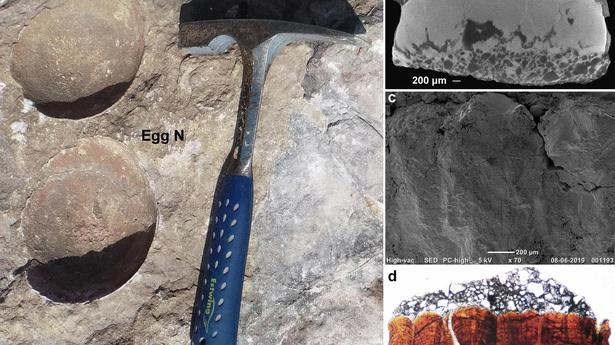
‘Abnormal’ dinosaur egg in India digs up new questions for evolution
The Hindu
Discovery leads to new connection between reptilian and avian evolution
A team of researchers from the University of Delhi has discovered a unique set of fossilised dinosaur eggs, with one egg nesting within the other at the Dinosaur Fossil National Park, in Dhar District of Madhya Pradesh. While eggs-within-eggs are rare phenomena, they are so far known to occur only in birds and have never known in reptiles. This discovery brings out newer connections between reptilian and avian evolution.
The findings, published in the journal Scientific Reports, talk about the ‘egg-in-egg’ phenomenon in a titanosaurid dinosaur egg found from the Bagh area of Dhar District in Madhya Pradesh
Dinosaurs of the Sauropod family were among the largest land animals that have ever lived and were widespread millions of years ago in the territory that is now India. Fossils of these animals have been found in Gujarat, Madhya Pradesh as well as Meghalaya.
The Upper Cretaceous Lameta Formation of Central India is long known for its dinosaur fossils (both skeletal and egg remains), and scientists, some of whom were involved in the team reporting the latest findings, documented 52 titanosaurid sauropod nests near Padlya village close to Bagh town in Madhya Pradesh. One of these nests consisted of 10 eggs, one of which was the “abnormal” egg.
The egg has two continuous and circular eggshell layers separated by a wide gap like that observed in birds. Until this discovery, no egg-in-egg fossil egg was found in dinosaurs and other reptiles such as turtles, lizards, and crocodiles.
It was believed that dinosaurs had a reproductive function similar to that of turtles and other reptiles (unsegmented oviduct) in contrast to segmented reproductive tract of crocodiles and birds with separate regions of membrane and shell deposition.
Although crocodiles have separate regions of shell membrane and mineralised shell deposition, they ovulate and release all the eggs simultaneously like turtles and other reptiles. In birds, ovulation is sequenced and eggs are laid one at a time. “The new discovery of an ovum-in-ovum egg, characteristic of birds in titanosaurids are for a segmented oviduct as in crocodiles and birds and possible sequential laying of eggs as in birds,” the authors aver.

 Run 3 Space | Play Space Running Game
Run 3 Space | Play Space Running Game Traffic Jam 3D | Online Racing Game
Traffic Jam 3D | Online Racing Game Duck Hunt | Play Old Classic Game
Duck Hunt | Play Old Classic Game